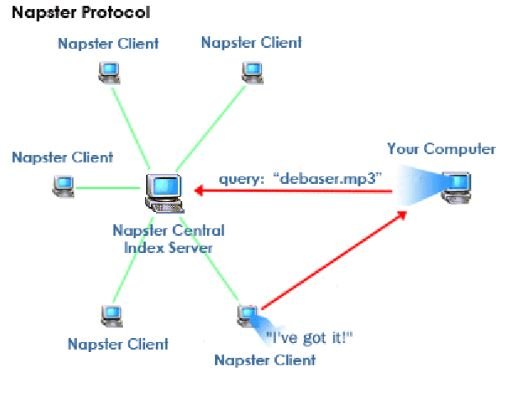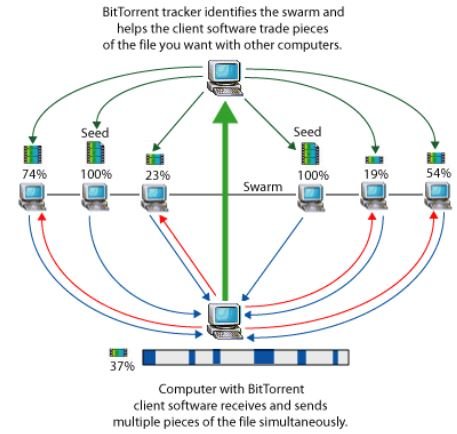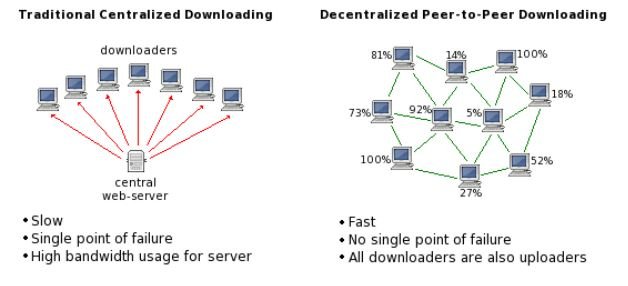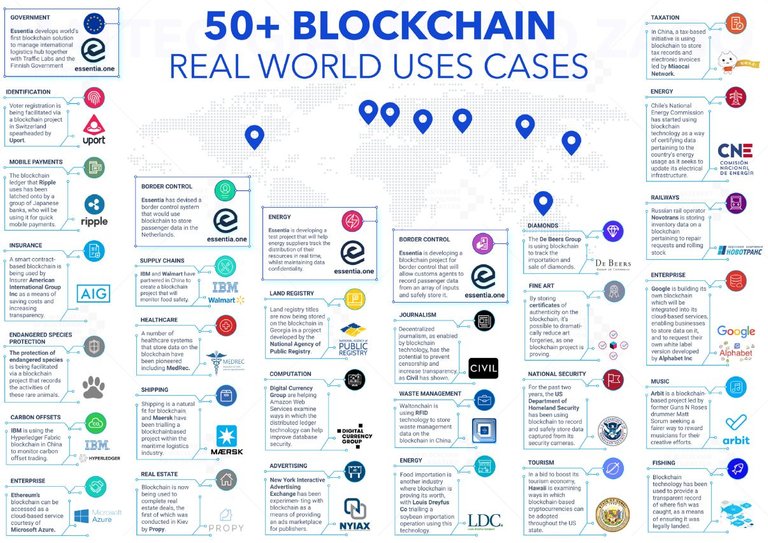In our previous articles we travelled the journey of early cryptographers (Part 1) and introduce ourselves to Open Source Software (Part 2) and their significance in developing the world’s first cryptocurrency, Bitcoin. In this article we will look deeper into P2P sharing networks and how they enable us to make resilient blockchains that not even governments are able to stop.
Peer to Peer Sharing Networks
Peer to peer sharing is a technological breakthrough that It allows for the distribution and sharing of information, using a P2P software program for searches for other connected computers on the network, to locate the desired information. In 1999, the first P2P Sharing network was Napster, and consisted of a file sharing application and a set of central servers. The central servers indexed the users and their shared content and and allowed for searches of available copies of that file and presented them to the user. The files would be transferred directly between the two private computers. Because this process occurred on a central server, however, Napster was held liable for copyright infringement and shut down in July 2001.
In the same year, a programmer called Bram Cohen, released a program called Bittorrent, a communication protocol for peer-to-peer file sharing (P2P) which is used to distribute data and electronic files over the Internet. To send or receive files, a person uses a BitTorrent client on their Internet-connected computer. A BitTorrent client is a computer program that implements the BitTorrent protocol. BitTorrent trackers provide a list of files available for transfer, and allow the client to find peer users known as seeds who may transfer the files. In principle, it is a file sharing protocol, relying on central servers called trackers to coordinate users. However, it does not form a network in the traditional sense. Instead new, separate networks of coordinating users are created for every set of files, called a torrent.
P2P Sharing quickly become the rival of the entire movie and music industry as it became the one stop shop to illegally download any movie, series or song. Despite numerous lawsuits and raids against websites, like The Pirate Bay, the gigantic entertainment industry has still not been able to stop this technology. The network became truly resilient to any form of censorship or manipulation as each user was part of the network instead of having a centralised model with all information stored on one central server. The same concept is used in Blockchain and Bitcoin, in which anyone who holds a copy of the ledger history and shares it with the rest of the network. To shut such a system down, you will need to shut down all the nodes at the same time, which is nearly impossible.
BitTorrent is a particularly interesting case as it has a built-in incentive mechanism. The more files peers seed the faster their downloads are, while peers that seed fewer or no files will find that the frequency of file segments they can download from another peer are artificially limited, so essentially they are rewarded to behave honestly and contribute to the health and value (content) of this system. There is a downside to this though. This incentive mechanism leaves new peers with a problem, in the case they have nothing to seed, so their downloads may be slower. Another interesting incentive that also includes the concept of randomness, is the use of 'optimistic unchoking', in which a random peer is selected for unthrottled downloads, on the assumption that it may pay off. Overall, the BitTorrent network consists of volunteers and would work better with monetary incentives. For example, a peer without file segments wanting to download faster could potentially pay a seeding peer to unchoke it, increasing its download performance, and using the blockchain to track it all.
Bram Cohen, the founder of BitTorrent, left BitTorrent, Inc. in a day to day capacity to co-found Chia.Network in the fall of 2017. The idea behind Chia is to utilize the already widely distributed sunk cost of unutilized storage space with the combination of a proof of space and proof of time protocol as a greener solution than Bitcoin.
We recently seen a trend of increasing P2P decentralized exchanges being built or being operated and maintained exclusively from software, such as IDEX, OpenLedger, district0x, Bisq, Airswap, Raiden and many more. Decentralized exchanges, run on top of the Ethereum network use smart contracts or a combination of smart contracts and payment channels to facilitate the trade of crypto assets. There is no middleman or single trusted entity involved and the trust is provided to the immutable and decentralized aspect of a smart contract. They often provide fully decentralized trades that do not require any name, email ID or verification. Moreover they often use Tor to provide a truly anonymous peer-to-peer network, and don’t hold fiat or bitcoins on their servers or in their account. Every aspect of this new generation of exchanges is decentralized from placing the order, to matching the order, to executing it. These Peer to Peer exchanges are practically invulnerable to government interference, because they don’t have any central point of authority which could be coerced.
On the other hand, since it is a relatively new kind of service, P2P exchanges are still less intuitive to use, have lower trading volumes because very few people actually do use them currently, and trade time can take much longer to be executed. Moreover, it is very unlikely that any professional traders would ever use it as they require fast settlement to make timely deals. In their current state the advantages they offer a resilience, privacy, security and freedom of payments. Perhaps the solution to this problem would be to have open order books from all the DEXs and doing intra-DEX transactions while also allowing a centralized exchange to use this open order books for their own matching.
Exchanges is only one application of P2P decentralized network of trust. The new generation of dApps, decentralized applications aim to solve real world problems in eCommerce, IoT, AI, FinTech, Identity Verification, Media Copywriting, Content Distribution, Bookings, and Gaming industry among others.
See you in the next article!
At this point we will take a break to digest the information. On our next article, we will be looking deeper into how these protocols, system and incentives all work together to provide the foundation on which new decentralized digital economies are created, and the formation of a new chapter in Economics, called Crypto-Economics.
End of Part III
Sources:
https://www.researchgate.net/figure/The-Napster-protocol_fig6_242320308
https://chia.net/
http://www.bittorrent.org/bittorrentecon.pdf
https://en.wikipedia.org/wiki/Bram_Cohen
http://p2pfoundation.ning.com/forum/topics/project-kleinrock-making-the
https://view.publitas.com/chia-network/chia-1/page/2
https://coinsutra.com/best-decentralized-exchanges-dex/
https://idex.market/eth/aura
https://openledger.io/welcome
https://wallet.crypto-bridge.org
https://bisq.network/
https://cointelegraph.com/explained/p2p-cryptocurrency-exchanges-explained
https://medium.com/herdius/decentralized-vs-centralized-exchanges-bdcda191f767
https://trinity.tech/
https://neonexchange.org/
https://www.adex.network/
https://www.zeepin.io/
https://www.apexnetwork.io/
https://medium.com/@matteozago/50-examples-of-how-blockchains-are-taking-over-the-world-4276bf488a4b




We hope everyone enjoy's Part 3, and we have the final one being released soon! Stay tuned! :)
Wow taking us back to the days of napster. I just missed napster, i found kazaa, limewire, frostwire etc